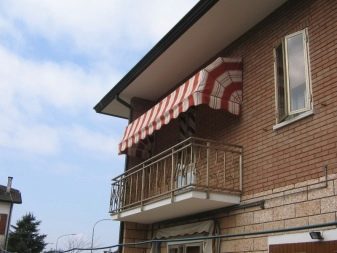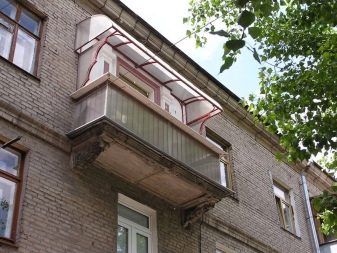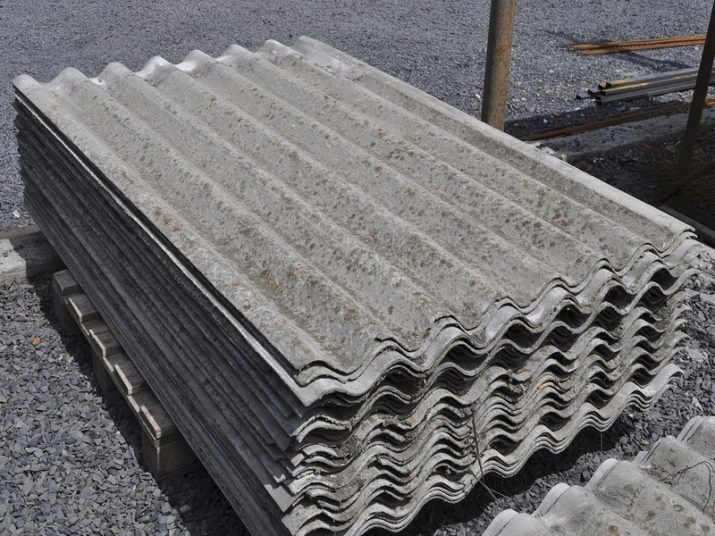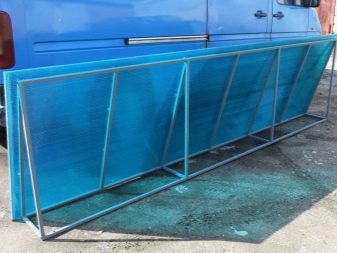Balcony visor: types and subtleties of installation

Many balconies in an apartment are used as a useful additional room, where, with the correct layout of the space, you can not only relax, but also store workpieces, dry clothes. Most balconies are open spaces that are practically unprotected, so dust and precipitation can easily get there from the street. To prevent this, it is necessary to install a visor. It will reliably protect from snow, rain, and will also serve as an original design decor.

Peculiarities
A balcony is an architectural part of a building's façade, which should be fitted with a canopy to increase functionality. This is especially true for open structures located on the most recent floors. In this case, it performs two tasks simultaneously: prevents precipitation and replaces the roof.


When choosing and installing, it is important to take into account the features of the material that was used when making the visor, because the structure must withstand significant loads.
In the classic version, the balcony visor looks like a frame sheathed with decorative material; it is an autonomous structure that can independently hold and cover the entire area of the balcony space. Unlike the roof, it is attached to the outside of the balcony with strong bolts (on steel corners), acting as a continuation of it. As for the roof, it is usually installed on special supports or attached to the load-bearing wall. If you install a balcony visor, then you can get many advantages from this solution:
- decorative finishing;
- protection of things and people from direct rays of the sun and, accordingly, ultraviolet radiation;
- reducing the ventilation of the interior;
- protection of the apartment from the penetration of thieves who can easily get into it through the roof.




As for the shortcomings, they also exist:
- installation of the visor is considered quite costly;
- during the installation of the structure, it is important to do the calculations correctly, otherwise it may be unsafe;
- the balcony needs to be additionally insulated, since in the cold season it will become a source of heat loss.


Types of awnings
Today, balcony canopies are represented by a huge selection of models. This type of structure performs not only a protective function, but also an aesthetic one, therefore, in order to give the balcony an original look, manufacturers try to make them in various shapes and configurations. Visors, depending on design and technical characteristics, are divided into five types.
- Single-pitch straight and inclined... The former are the most effective in controlling the penetration of precipitation. The only thing is that, due to the lack of a slope, snow masses can accumulate on the balcony or icicles form. Therefore, it is best to give preference to inclined single-slope models.


Due to the inclination, precipitation on their surface does not linger, and the installation of such canopies is much easier than single-slope straight lines.
- Gable. They are characterized by high protection against gusts of wind, due to the fact that they have the form of an equilateral triangle, outwardly resemble a roof. Looks great in large sizes. To make this type of visor decorative, they are often decorated with forged elements along the edges, while the frame can be clad with any material. A forged visor can be either simple or folding, which has many twisted shapes.


- Arched... In such structures, the roof has an arched shape, they look organically in any style. The only thing is that it is quite difficult to install such visors on your own, you need to have certain skills and a curved rafter. They are characterized by reliable protection and give the structure a modern look. The curved shape does not allow rain, snow to linger on the surface, and also perfectly withstands gusts of wind.


Various materials can be used to produce this unusual visor.
- Dome (tent). These models are not only difficult to manufacture, but also difficult to assemble. They look impressive, the varieties of transparent type polycarbonate deserve special attention. They are especially well suited for installation on the top floors of buildings. The only drawback of the model is the great difficulties in the case of self-production.


- Awnings. These are the so-called frame structures, on the supports of which dense fabric is stretched. Often, these models are equipped with an electric drive, which is necessary to open or close the awning. The lifting mechanism is usually attached to the wall. Awnings, like the previous options, are well suited for placement on the last floors; they are usually made of strong acrylic canvases of a rather bright color.


Manufacturing materials
Visors for loggias and balconies are made of all kinds of materials that may differ in both design and performance. Most often, for the production of awnings they use ondulin, slate, corrugated board, polycarbonate, glass.
- Ondulin... This is the cheapest material that looks like slate in appearance, but differs from it in its low weight and flexibility. Ideal for coating, because it withstands the negative effects of the external environment and is resistant to the formation of mold and mildew. Ondulin is produced in various shades, which makes it easy to match it to any balcony style.


- Slate. It is characterized by a low level of thermal conductivity, which makes it possible to maintain an optimal microclimate inside the balcony room (regardless of weather conditions). In addition, slate is distinguished by high technical characteristics and design expressiveness.

This material has durability and strength, but in order to provide the balcony with protection from leaks, you should additionally install waterproofing.
- Decking. This material is made from polymers that are galvanized. Therefore, it turns out to be resistant to corrosion, external influences and mechanical damage. Profiled sheeting is produced in the form of sheets with a corrugated structure, it perfectly withstands any load. The advantages include a huge selection of colors.


- Polycarbonate. This material is highly durable, but is afraid of mechanical stress. It resembles translucent plastic and is often used to create open protective structures of various shapes. The main advantages are good sound insulation and the ability to transmit the rays of the sun. Polycarbonate is made of specially tempered triplex glass, so it makes an excellent coating for the balcony, which not only makes the structure inside warm, light, pleasant, but also gives it an aesthetic appearance. Minus - requires special care.


- Glass. Balconies with a similar visor look interesting; in this case, safety glass (laminated, tempered) is usually used. The structure can be installed in various sizes, since there are no standards - it all depends on the strength of the balcony and on the personal preferences of the apartment owners. The disadvantage of glass canopies is the high price.


In addition to the above, visors also cover galvanized, steel sheets and tiles. These materials are considered budgetary, have a long service life, and allow you to create original designs. The only drawback of the material is poor sound insulation.


An unusual solution for decorating a balcony will be installation of a forged visor, which will give the structure an airiness and originality... For manufacturing, a solid metal rod is mainly used, which, in comparison with shaped hollow pipes, is able to withstand different loads. If we consider the reliability of forged canopies, then they are in many ways superior to those made of screw connections.


To prolong their service life, it is recommended to cover them with paint or zinc.
Stages of work
Installation of a balcony visor is not particularly difficult, so many do it on their own. Problems can only arise when installing a structure on the very last floor. First of all, you need to create a project, prepare the required tools and raw materials. For work, you will need devices for welding, metal processing, a brush, sandpaper, a screwdriver, sealant, dowels, anchors.

At the design stage of the project, consider the size of the structure and its shape. To do this, first carry out measurements and make a drawing, according to which the required amount of material is calculated. After that, you need to perform actions, adhering to the following instructions:
- the first step is to weld a steel frame, which in the future will serve as a canopy;
- the frame should be installed against the wall in such a way that there are no gaps, all seams should be treated with a sealant;
- it is advisable to make soundproofing of the canopy, which will provide apartment owners with a comfortable stay without noisy sounds from the street;
- then you will need to process all metal parts with a special solution that protects against corrosion, and proceed to the direct laying and fixing of the roofing sheets.

If you plan to install a polycarbonate visor, then the procedure will be slightly different.
- The type of the future visor is chosen, which was described in detail above, and the design of the structure is done, taking into account the fact that it should protrude beyond the edges of the balcony by at least 30 cm.This will protect the interior space from rain, snow and wind.
- A metal structure is preliminarily constructed (it should have the form of a frame), it is attached both to the balcony railing and to the wall. For this, trusses are welded from the corners of 40 * 40 mm, and markings are made on the wall of the house, where the future location of the lower and upper horizontal strips is marked. The distance between them should be equal to the height of the metal trusses, on top of which the sheathing of boards or timber is laid.
- After that, insulation should be performed by laying thermal washers. The structure can be covered with both cellular polycarbonate and monolithic polycarbonate. In this case, the first type of material has greater strength, since its basis is a hollow sheet, which has internal bridges. As for monolithic polycarbonate, it is suitable when you need to build a structure of complex shape. It is best to fasten the sheets with anchor bolts, since they have increased strength and are able to press the material well, increasing its resistance to wind loads.




For information on how to make a visor for a balcony, see the next video.








